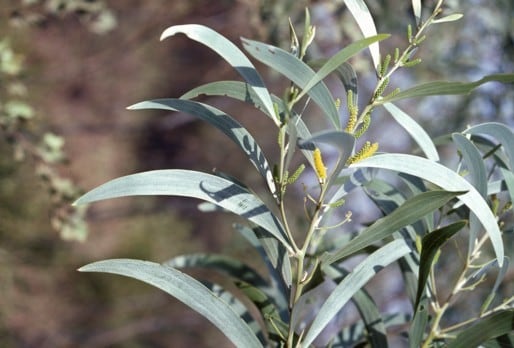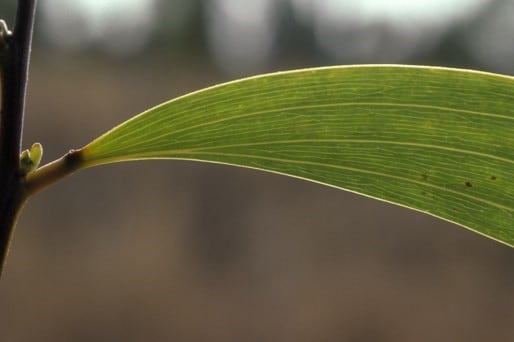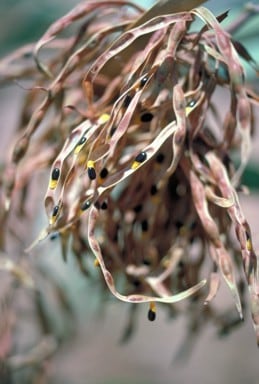Acacia elachantha M.W.McDonald & Maslin
WATTLE
Acacias of Australia
Family
Fabaceae
Distribution
Occurs mainly in the tropical arid zone region between latitudes 17°–24°S, extending from the Pilbara and Kimberley regions in W.A. across N.T. to central and south-western Qld. and far north-eastern S.A. (on Cordillo Downs Stn).
Description
Spindly shrub 2–3 m high, rarely a tree 5–6 (–8) m high; crown sparsely foliaged. Branchlets angled at extremities becoming terete with age, glabrous or minutely sericeous. New shoots glabrous or sericeous with yellow or silver hairs. Phyllodes shallowly to strongly falcate, 8–19 (–20) cm long, 7–22 mm wide, coriaceous, either glabrous and lightly pruinose or minutely sericeous; longitudinal nerves numerous, 2–4 per mm, with normally 3 more prominent than the rest and the lowermost 2 running together at base of phyllode; minor nerves occasionally anastomosing. Inflorescences 1 or 2 per axil, simple or vestigial binate racemes with axes to 1 mm long; peduncles 3–12 mm long, hairy or glabrous; spikes 1.5–3.3 cm long, light golden; bracteoles spathulate, 0.5 mm long. Flowers 5-merous; sepals united; ovary hairy or glabrous. Pods linear, straight to shallowly curved, 3–3.5 (–4) mm wide, chartaceous to coriaceous, glabrous to very sparsely minutely hairy. Seeds longitudinal, ±oblong, 3.5–4 mm long, glossy, dark brown to black; aril yellow.
Phenology
Flowers May–Aug.
Habitat
Grows mainly on red sand plains, run-on sites associated with low rocky hills or lateritic plains.
Specimens
W.A.: Millstream pipeline access rd, 1.5 km W of Karratha rd (c. 3 km due S of Karratha township), B.R.Maslin 5748 (PERTH); 11.6 km W of Kiwirrkurra, G.J.Morse 2557 (PERTH). N.T.: 28 km N of Daly Waters township turnoff on Stuart Hwy, B.R.Maslin 7410, M.McDonald & G.Leach (CANB, DNA, PERTH). S.A.: Cordillo Downs Stn, P.E.Conrick 2231 (AD, PERTH). Qld: 5 miles [8 km] SE of ‘Arrabury’ on ‘Lake Pure’ road, J.Pickard 1768 (K, NSW).
Notes
Acacia elachantha is a fast growing, short-lived species that produces prolific quantities of seed. Introduced into parts of west Africa (as A. cowleana) since the early 1980s for fuelwood, soil rehabilitation and more recently for the use of its seeds as an alternative food. Based on allozyme evidence, populations of A. elachantha have almost no genetic differentiation either within or between populations (Moran et al., in A.P.N.House & C.E.Harwood (eds), Australian Dry-Zone Acacias for Human Food 78–79 (1992); referred to as A. cowleana). This study also found that glasshouse-grown progeny were genetically identical to the parents suggesting A. elachantha has allopolyploid origins and/or an apomictic breeding system. Hybridisation between A. elachantha and A. neurocarpa (cited as the diploid race of A. holosericea) was also suggested as the origin of the hexaploid species A. colei.
Two variants, distinguished mainly on the presence or absence of indumentum, were recognised by M.W.McDonald & B.R.Maslin, Austral. Syst. Bot. 10: 303–320 (1997), but further study is required to resolve their taxonomic status; the above description incorporates both taxa but specimens cited refer only to typical A. elachantha. The hairy variant is more widely distributed and more commonly collected than the glabrous variant which is presently known as Acacia sp. Urandangie (L.Pedley 2025). Acacia elachantha is closely allied to, and previously confused with, A. cowleana and the two could be considered cryptic species. Apart from its mainly creek bank habitat and its more southerly distribution, A. cowleana is distinguished from A. elachantha by its more robust habit and foliage, its resinous new shoots, its longer spikes with larger flowers and its wider pods, see M.W.McDonald & B.R.Maslin, loc. cit., for further discussion. The two species sometimes putatively hybridize in the Mitchell district, Qld. The differences between these two species and their closest relatives, A. colei, A. leptocarpa, A. longispicata, A. thomsonii and hybrids involving A. colei × A. elachantha and A. elachantha × A. gonoclada are documented in M.W.McDonald & B.R.Maslin, loc. cit. Also related to A. holosericea and its allies and is superficially similar to A. fecunda.
Further details on the ecology and utilisation of A. elachantha (referred to as A. cowleana) are given in J.C.Doran & J.W.Turnbull (eds), Australian Trees & Shrubs: Species for Land Rehabilitation & Farm Planting in the Tropics 134–135 (1997) and by P.Latz, Bushfires & Bushtucker 94 (1995).
FOA Reference
Data derived from Flora of Australia Volumes 11A (2001), 11B (2001) and 12 (1998), products of ABRS, ©Commonwealth of Australia
Author
M.W.Mcdonald
Minor edits by B.R.Maslin, J.Reid & J.Rogers
This identification key and fact sheets are available as a mobile application:
URL: https://apps.lucidcentral.org/wattle/
© Copyright 2018. All rights reserved.















